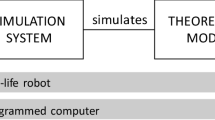Abstract
Simulation in robotics is often a love-hate relationship: while simulators do save us a lot of time and effort compared to regular deployment of complex software architectures on complex hardware, simulators are also known to evade many of the real issues that robots need to manage when they enter the real world. Because humans are the paragon of dynamic, unpredictable, complex, real world entities, simulation of human-robot interactions may look condemn to fail, or, in the best case, to be mostly useless. This collective article reports on five independent applications of the MORSE simulator in the field of human-robot interaction: It appears that simulation is already useful, if not essential, to successfully carry out research in the field of HRI, and sometimes in scenarios we do not anticipate.
Access this chapter
Tax calculation will be finalised at checkout
Purchases are for personal use only
Preview
Unable to display preview. Download preview PDF.
Similar content being viewed by others
References
Breazeal, C., DePalma, N., Orkin, J., Chernova, S., Jung, M.: Crowdsourcing human-robot interaction: New methods and system evaluation in a public environment. Journal of Human-Robot Interaction 2(1), 82–111 (2013)
Echeverria, G., Lemaignan, S., Degroote, A., Lacroix, S., Karg, M., Koch, P., Lesire, C., Stinckwich, S.: Simulating complex robotic scenarios with MORSE. In: Noda, I., Ando, N., Brugali, D., Kuffner, J.J. (eds.) SIMPAR 2012. LNCS, vol. 7628, pp. 197–208. Springer, Heidelberg (2012)
Garrell, A., Sanfeliu, A.: Model validation: Robot behavior in people guidance mission using DTM model and estimation of human motion behavior. IEEE Transactions on Intelligent Robots and Systems (IROS), 5836–5841 (2010)
Gratch, J., Rickel, J., André, E., Cassell, J., Petajan, E., Badler, N.: Creating interactive virtual humans: Some assembly required. IEEE Intelligent Systems 17(4), 54–63 (2002)
Guzzi, J., Giusti, A., Gambardella, L.M., Theraulaz, G., Di Caro, G.A.: Human-friendly robot navigation in dynamic environments. In: IEEE International Conference on Robotics and Automation (ICRA), pp. 423–430. IEEE (2013)
Henry, P., Vollmer, C., Ferris, B., Fox, D.: Learning to navigate through crowded environments. In: IEEE International Conference on Robotics and Automation (ICRA), pp. 981–986. IEEE (2010)
Hoffman, G., Breazeal, C.: Effects of anticipatory perceptual simulation on practiced human-robot tasks. Autonomous Robots 28(4), 403–423 (2010)
Karg, M., Kirsch, A.: An expectations framework for domestic robot assistants. In: Conference on Advances in Cognitive Systems, pp. 77–92 (2013)
Kidokoro, H., Kanda, T., Brscic, D., Shiomi, M.: Will I bother here? – A robot anticipating its influence on pedestrian walking comfort. In: 8th ACM/IEEE International Conference on Human-Robot Interaction (HRI), pp. 259–266. IEEE (2013)
Knepper, R.A., Rus, D.: Pedestrian-inspired sampling-based multi-robot collision avoidance. In: 21st IEEE International Symposium on Robot and Human Interactive Communication (RO-MAN), pp. 94–100. IEEE (2012)
Koenig, N., Howard, A.: Design and use paradigms for Gazebo, an open-source multi-robot simulator. In: IEEE/RSJ International Conference on Intelligent Robots and Systems (IROS), vol. 3, pp. 2149–2154. IEEE
Kunze, L., Kumar, K., Hawes, N.: Indirect object search based on qualitative spatial relations. In: IEEE International Conference on Robotics and Automation (ICRA), May 31-June 7 (2014)
Lemaignan, S., Karg, M., Mainprice, M., Kirsch, A., Alami, R.: Human-robot interaction in the MORSE simulator. In: 7th ACM/IEEE International Conference on Human-Robot Interaction (HRI). Late Breaking Reports (2012)
Lewis, M., Wang, J., Hughes, S.: USARSim: Simulation for the study of human-robot interaction. Journal of Cognitive Engineering and Decision Making 1(1), 98–120 (2007)
Lier, F., Lütkebohle, I., Wachsmuth, S.: Towards automated execution and evaluation of simulated prototype HRI experiments. In: 9th ACM/IEEE Conference on Human-Robot Interaction (HRI). Late Breaking Reports (2014)
Milliez, G., Ferreira, E., Fiore, M., Alami, R., Lefèvre, F.: Simulating human-robot interactions for dialogue strategy learning. In: Brugali, D., Broenink, J., Kroeger, T., MacDonald, B. (eds.) SIMPAR 2014. LNCS (LNAI), vol. 8810, pp. 62–73. Springer, Heidelberg (2014)
Milliez, G., Warnier, M., Clodic, A., Alami, R.: A framework for endowing interactive robot with reasoning capabilities about perspective-taking and belief management. In: Proceedings of the 23rd IEEE International Symposium on Robot and Human Interactive Communication (2014)
Sisbot, E.A., Marin-Urias, L.F., Alami, R., Simeon, T.: A human aware mobile robot motion planner. Transactions on Robotics 23(5), 874–883 (2007)
Sun, R.: Cognition and multi-agent interaction: From cognitive modeling to social simulation. Cambridge University Press (2006)
Szymanezyk, O., Duckett, T., Dickinson, P.: Agent-based crowd simulation in airports using games technology. In: Nguyen, N.-T. (ed.) Transactions on CCI VIII. LNCS, vol. 7430, pp. 192–213. Springer, Heidelberg (2012)
Kruse, T., Khambhaita, H., Kirsch, A., Alami, R.: Evaluating directional cost models in navigation. In: 9th ACM/IEEE Conference on Human-Robot Interaction (HRI), Bielefeld, Germany (2014)
Trafton, G., Hiatt, L., Harrison, A., Tamborello, F., Khemlani, S., Schultz, A.: Act-R/E: An embodied cognitive architecture for human-robot interaction. Journal of Human-Robot Interaction 2(1), 30–55 (2013)
Treuille, A., Cooper, S., Popović, Z.: Continuum crowds. ACM Transactions on Graphics (TOG) 25, 1160–1168 (2006)
Wang, J., Lewis, M., Hughes, S., Koes, M., Carpin, S.: Validating USARsim for use in HRI research. Human Factors and Ergonomics Society Annual Meeting 49(3), 457–461 (2005)
Author information
Authors and Affiliations
Editor information
Editors and Affiliations
Rights and permissions
Copyright information
© 2014 Springer International Publishing Switzerland
About this paper
Cite this paper
Lemaignan, S. et al. (2014). Simulation and HRI Recent Perspectives with the MORSE Simulator. In: Brugali, D., Broenink, J.F., Kroeger, T., MacDonald, B.A. (eds) Simulation, Modeling, and Programming for Autonomous Robots. SIMPAR 2014. Lecture Notes in Computer Science(), vol 8810. Springer, Cham. https://doi.org/10.1007/978-3-319-11900-7_2
Download citation
DOI: https://doi.org/10.1007/978-3-319-11900-7_2
Publisher Name: Springer, Cham
Print ISBN: 978-3-319-11899-4
Online ISBN: 978-3-319-11900-7
eBook Packages: Computer ScienceComputer Science (R0)




